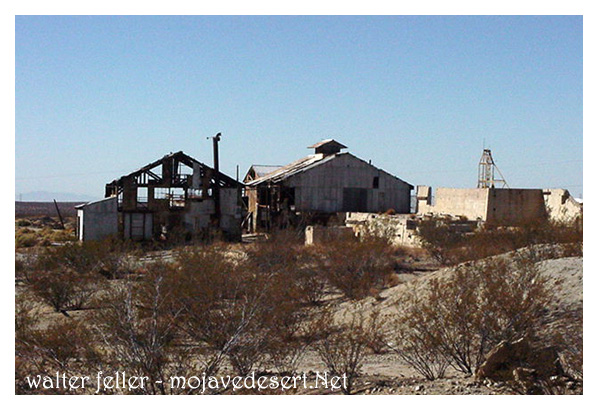Atolia-Randsburg Tungsten Boom

(The Atolia tungsten mines and the California Rand Silver Mine are actually located in San Bernardino County near the San Bernardino-Kern County line. Their story is included here as the logical continuation of the Randsburg area mining history)
Randsburg by the beginning of the twentieth century has settled into a calm period of average, modest mining production. No new gold discoveries were made after 1900 and the easy diggings had been worked and reworked. The lode mines were being run by companies and corporations, and the gold placers yielded less and less. Since 1896 miners and prospectors in the Stringer District (southeast of Randsburg) had been cursing the unwanted appearance of a creamy white substance in their pans and dry washers that was interfering with the gold recovery. The nasty stuff was nicknamed "heavy spar." 36
It was actually scheelite, tungsten ore. Hundreds had discovered " heavy spar before, cursing it for getting in the way. Yet when George Gay and Pat Burns found float at the St. Elmo Mine in 1904, they recognized it as scheelite. In trying to trace the float back to its source, the two missed the rich Atolia veins but discovered that the Stringer District veins contained tungsten values. 37
Randsburg stirred and yawned as men ran back to the Stringer District to relocate that "heavy spar." What was once cursed was now coveted! Gay and Burns missed the rich veins of the Atolia District because the veins were entirely covered by detritus except at one location. In the excitement that the two created, this was soon discovered as the Papoose, which from 1908 to 1911 was the leading scheelite mine in the world. With the Papoose discovery and the later location of the Union Mine, Randsburg had something to shout about. Her second boom was on, even though, due to the more glamorous Nevada strikes ( Tonopah, Goldfield, Rhyolite), and a few California booms (Skidoo and Greenwater), Randsburg's jubilation went largely unnoticed outside the county.
Atkins and De Golia put up the first tungsten mill in 1907. Combining their names, the prospectors gave the name Atolia to their camp, located 4 miles south of Johannesburg. Atolia's 60 citizens dry washed the area for high grade float, and many worked for the Atolia Mining Company, which very quickly bought up all the good ground, becoming the owners of 56 claims accounting for 95 percent of the entire district's tungsten production.38
Atolia was becoming very wealthy and being very quiet about it, arousing no outside interest. The Atolia Mining Company produced close to $100,000 worth of ore in 1906, their first year of operation. By 1913, just 7 years later, they had produced $1,000,000 worth of ore. In 1914 the Atolia Mining Company sold 28,000 units of tungsten ore worth a total of $182,000. A unit is 20 pounds of ore containing 60 percent or more of tungsten trioxide. At that time a unit of ore sold for $6.50. Because of the wartime demand for tungsten (used as an alloy to harden steel), its price more than doubled in 1915 to $14 a unit. The Atolia Mining Company nearly doubled their production that year to 54,000 units, raking in $763,000 from ore worth only $360,000 the year before. The outside world began to notice Atolia and the population that year rose to 300.39
Atolia's biggest year was 1916, as the value of tungsten was skyrocketing. Doubling its production again, the Atolia Mining Company produced 108,000 units of ore at $33 a unit for a total of over three and a half million dollars. Atolia's population swelled to 2,000. Storekeepers took tungsten ore in exchange for groceries and merchandise, and Illingsworth and Dunnell, a local merchant house, received $200,000 worth of ore by May, 1916.
Eastern manufacturers sent buyers to Atolia to bid on tungsten ore like bushels of wheat or cotton, with prices for small amounts of high grade ore, in at least one instance, reaching $90 a unit. The buyers didn't ask too many questions as to where the tungsten came from, as highgrading was all too common. However, miners were watched as if they were mining South African diamonds; lunch pails were inspected daily, and ore was sealed before shipment by rail. Tungsten had become a precious metal 40
Water was almost just as precious in Atolia. Shipped in by rail from Hinkley, a tank car of water cost between $15 and $28. Until 1917, when the Randsburg Water Company pipeline reached Atolia, the mining company was doing it's best to conserve water and even caught rainfall with gutters on every building.
People in the Randsburg area made thousands of dollars from tungsten overnight. One S. E. Vermilyea purchased a lease for $2,000 and worried that he'd never recover his initial investment. Three days later he hit high grade ore and refused an offer of $25,000. A canvas bag the size of a shopping bag filled with high grade scheelite float was worth $350. Even children gathered the ore and made big money.41
Such an opportunity was too good to last. In 1917 the Atolia Mining Company sold 116,000 units, 8,000 more than were produced in 1916. Although this was worth more than two million dollars, this represented a loss of one and a half million dollars over what the same amount would have brought in 1916. The price of tungsten had dropped to $18 a unit.
Atolia tungsten production for 1918 was $1,525,000 from 61,000 units of ore at $25 a unit, and in 1919, when only 4,000 units were sold at $16 a unit, the Atolia boom was over. The next year the Atolia Mining Company didn't ship a single unit of ore. With demand down (World War I was over) and tungsten being quite inexpensively mined in China, Atolia seemingly died.42